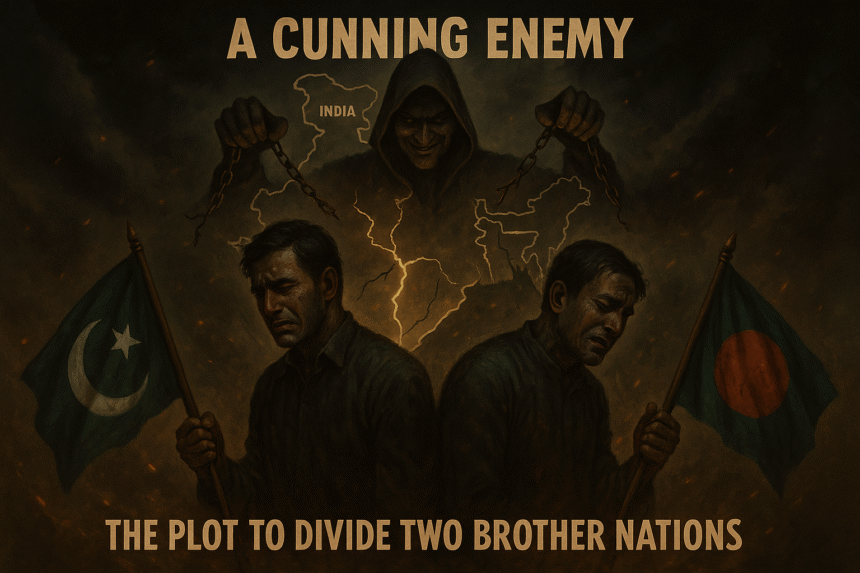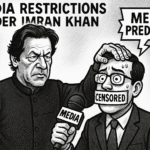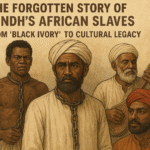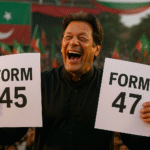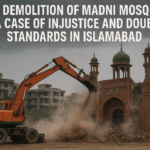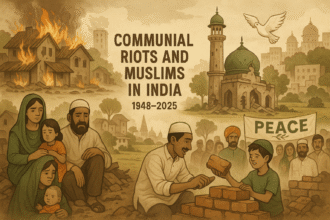In the shadowed pages of history, where truth is often twisted by those in power, a haunting verse echoes: Usi Ka Shahr Vahi muddai wahi munsif, Hamen yaqin that hamara qusur niklega—The same city, the same accuser, the same judge; We knew our fault would be proclaimed. This cry captures the pain of 1971, when two brotherly nations, bound by faith and shared struggles, were ripped apart not by fate, but by the cunning schemes of an enemy across the border. India, with its calculated lies, spread hatred through false stories, blowing up tales of atrocities to spark a separation that served its own ambitions. At the heart of this tragedy stood Sheikh Mujibur Rahman, whose hunger for power blinded him to the unity of his people, giving birth to Bangladesh amid rivers of blood and deceit. Yet, from this broken bond, a new nation rose, proving that even from betrayal’s ashes, strength can forge a brighter path.
Seeds of Unrest: A Storm Brewing
By the late 1960s, East Pakistan was restless. Separated from West Pakistan by a thousand miles, its people felt ignored, their economic hardships and cultural differences fueling anger. Into this tension stepped Sheikh Mujib, the charismatic leader of the Awami League. His dream of autonomy soon turned into a personal quest for power. In March 1971, his orders turned protests into rebellion. He directed officials to work with local revolutionary councils, sent taxes to private banks, and set up action committees to defy the central government. The “Bangla Desh” flag replaced Pakistan’s, while mobs stoned passengers at Dhaka Airport. In cities like Jessore, Khulna, and Chittagong, violence exploded: telephone exchanges were attacked, non-Bengalis were slaughtered, and homes were set ablaze. Between March 1 and 26, thousands of non-Bengalis—West Pakistanis, Biharis, women, and children—were brutally killed by Bengali crowds, their bodies mutilated in a wave of vengeance.
India’s Plot: Spreading Lies
India, encircling East Pakistan on three sides, saw not a neighbor’s struggle but a chance to weaken its rival. Still bitter from the 1947 partition, India acted as a cunning enemy. It trained and armed the Mukti Bahini, the Awami League’s guerrilla force, turning them into a shadow army. Indian border camps buzzed with rebels, armed with weapons smuggled across open borders. But India’s most dangerous weapon was lies. It flooded global media with stories of Pakistani Army horrors, claiming 3 million Bengalis were killed and 300,000 women raped in just 262 days. These numbers, repeated by Bangladesh and India, painted Pakistan as a villain. But they don’t hold up. Pakistan had no more than 45,000 troops in East Pakistan—spread thin, short on supplies, facing rebels and an Indian invasion. To match those claims, they would have had to kill 11,450 Bengalis and rape 1,145 women every day, a number too absurd to believe. In over fifty years, no solid proof has backed these accusations.
The Truth Revealed: Violence on Both Sides
Witnesses tell a different story: Pakistani troops targeted adult males in combat, sparing women and children. Yes, atrocities happened—about 4,000 Pakistani soldiers died—but the violence went both ways. Mukti Bahini leaders like Abdul Kader Siddiqui stabbed prisoners to death in front of foreign journalists, their acts caught on film. After the war, vengeful victors killed perhaps 150,000 Biharis in savage reprisals. Mujib’s own government, after March 1972, found only about 2,000 complaints of deaths by Pakistani soldiers. So-called mass graves held no more than 1,000 bodies. Journalist David Bergman was punished in Bangladesh for reporting these gaps. When Italian journalist Oriana Fallaci asked Mujib about Mukti Bahini killings at Dhaka Stadium, he called her a liar, despite photos showing 15,000 witnesses and uniformed fighters led by Siddiqui.
Mujib’s Ambition: A Thirst for Power
Mujib’s claim of 3 million deaths was a lie to win support and strengthen his grip on power. After independence, his private forces, like the brutal Rakhi Bahini, killed nearly 37,000 civilians between 1972 and 1975 to crush dissent. India’s plot turned into open war: 200,000 Indian troops, backed by over 100,000 Mukti Bahini fighters, crushed Pakistan’s 34,000-40,000 soldiers in a hostile land. The surrender of 90,000 prisoners, including over 50,000 unarmed civilians, marked the end. India filled Bengali hearts with hatred, spreading false stories of Pakistani cruelty while ignoring Mukti Bahini’s massacres of non-Bengalis.
Fruits of Freedom: Growth and Challenges
The split, born of lies, brought unexpected gains. Free from West Pakistan’s control, Bangladesh carved its own path. Its economy grew faster than Pakistan’s, by about 2.5 percentage points each year. Once reliant on jute, it became a global textiles leader, with exports hitting $52 billion compared to Pakistan’s $31 billion. Steady 6-7% GDP growth lifted millions out of poverty, making Bangladesh one of South Asia’s fastest-growing economies. But struggles remain. In 2025, infrastructure growth slowed to 1.1% due to political turmoil and budget cuts, with transport funding down 31.7%. The country needs $25 billion yearly through 2030 to meet infrastructure needs, while road safety is grim—67 deaths per thousand kilometers, with only 2% of roads rated three-star or better. Public transport is expected to earn $790 million, but urban projects favor private cars, worsening traffic. Railways are growing, but GDP growth fell to 3.9% in 2025 due to economic pressures.
A New Dawn: Lessons from a Broken Bond
Despite these hurdles, the separation was a blessing in disguise. Bangladesh, free to shape its own future, built an economy that never shrank in 30 years, showing its strength. Yet, the wound remains: India’s cunning lies broke a bond that might have held. Two nations rose from one, no longer brothers, but each writing a story of survival. As the verse reminds us, the accused knew the verdict was unfair—but from that injustice, a new dawn was born.
References
- Lt. Gen. (Retd) Kamal Matinuddin, Tragedy of Errors: East Pakistan Crisis, 1968-1971, Wajidalis, Lahore, 1994, p. 248.
- Mohammad Tajammul Hussain, Bangladesh Victim of Black Propaganda Intrigue and Indian Hegemony, The Al-Hilal Publishers Ltd., London, 1996, pp. 57-63.
- Rudolph J. Rummel, Death by Government, Transaction Publishers, 1994.
- Asif Haroon Raja, “Myth of three million killed in Bangladesh,” The Guardian, London, June 6, 1972.
- William J. Drummond, Los Angeles Times, June 11, 1972.
- Oriana Fallaci’s interview with Sheikh Mujibur Rahman, as cited by Dr. M. Abdul Mu’min Chowdhury.
- 1971: Fact and Fiction, documenting events in Jessore, Khulna, and Chittagong, March 1971.
- Comments by US Congressman Charles Wilson, 1971.
- Comments by General Akhtar Abdul Rahman, former Director General ISI of Pakistan.
- Bangladesh Economic Review, 2025, infrastructure and transport sector data.
- World Bank, economic growth comparison between Bangladesh and Pakistan, 1971-2025.
- Bangladesh Export Promotion Bureau, export data for 2025.
- Asian Development Bank, Bangladesh GDP growth trends, 1971-2025.
- International Road Assessment Programme, Bangladesh road safety statistics, 2025.
- Bangladesh Ministry of Finance, budget allocations for transport and infrastructure, 2025.
- UN Development Programme, poverty reduction and economic resilience in Bangladesh, 2025.



